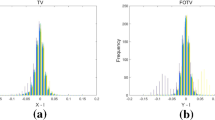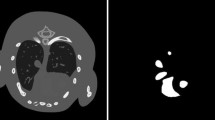Abstract
The photon counting image collected under 10− 4 lux environment has a degraded image quality due to background noises and other problems. Bayesian estimation is a classical approach for photon counting image restoration and regularization has also been widely used in image processing. However, the regularization method is not suitable for photon counting images with extremely lack of information, and the recovery effect of Bayesian estimation in images mixed with unknown noise is not ideal. The main contribution of this paper is that on the basis of Bayesian estimation, the regularization method is introduced to solve the problem of restoring photon counting images mixed with unknown noise under 10− 4 lux environment. The original part is that the gamma distribution of the expected value of photon counting is used as its prior condition, and the error function is expressed as the form of the norm to establish the objective function. Through an approximate iterative solution, the optimal estimation of the photon counting expectation is carried out to achieve the optimal restoration of the photon counting image. Experiments demonstrate that the background noise is effectively removed and the image quality is improved after restoring photon counting images. Also, the final result of the proposed method is superior to other comparative methods in multiple evaluation indexes and achieved better effects.










Similar content being viewed by others
Explore related subjects
Discover the latest articles, news and stories from top researchers in related subjects.References
Wang F, Wang Y, Yang M, et al. (2017) A denoising scheme for randomly clustered noise removal in ICCD sensing Image. Sensors 17(2):233
Xiao S (2010) Research on image restoration and its related technology within the Bayesian framework. South China University of Technology
Zhan Y, Wu JB, Ding MY, et al. (2018) Nonlocal means image denoising with minimum MSE-based decay parameter adaptation. IEEE Access 7:130246–130259
Jose JR (2009) SOFMLS: Online self-organizing fuzzy modified least-squares network. IEEE Trans. Fuzzy Sys 17:1296–1309
Yi X, Park D, Chen Y, et al. (2016) Fast algorithms for robust PCA via gradient descent. In: Proc. 29nd Int. Conf. Neural Inf. Proc.ss. Syst. (NIPS), pp 4152–4160
Li J, Kong Y, Zhao H, et al. (2016) Learning fast low-rank projection for image classification. IEEE Trans Image Process 25(10):4803–4814
Zuo C, Jovanov L, et al. (2016) Image denoising using quadtree-based nonlocal means with locally adaptive principal component analysis. IEEE Signal Process Lett 23(4):434–438
Gao G, Jing XY, Huang P, et al. (2016) Locality-constrained double low-rank representation for effective face hallucination. IEEE Access 4:8775–8786
Zhang FL, Yang GW, Yang ZJ, et al. (2017) Robust recovery of corrupted image data based on l1-2 metric. IEEE Access 6:5848–5851
Guo Z, Sun Y, Jian M, et al. (2018) Deep residual network with sparse feedback for image restoration. Appl Sci 8:2417
Zou J, Shen M, Zhang Y, et al. (2018) Total variation denoising with non-convex regularizers. IEEE Access 7:4422–4431
Zhang M, Chen Y, Pan Y, et al. (2019) A fast image deformity correction algorithm for underwater turbulent image distortion. Sensors 19:3818
Liu F, Song QZ, Jin GH (2020) The classification and denoising of image noise based on deep neural networks. Appl Intell 50:2194–2207
Israel E, Jose JR, Dany IM, et al. (2020) Genetic algorithm with radial basis mapping network for the electricity consumption modeling. Appl Sci 10:4239
Gustavo A, Jose JR, et al. (2020) Novel nonlinear hypothesis for the delta parallel robot modeling. IEEE Access 8:46324–46334
Arablouei R, Hoog FD (2016) Hyperspectral image recovery via Hybrid regularization. IEEE Trans Image Process 25(12):5649–5662
Azzari L, Foi A, et al. (2016) Variance stabilization for Noisy+Estimate combination in iterative poisson denoising. IEEE Signal Process Lett 23(8):1086–1090
Yunyi L, Fei D, Xiefeng C, et al. (2019) Multiple-prespecified dictionary sparse representation for compressive sensing image reconstruction with nonconvex regularization. J Franklin Inst 356(4):2353–2371
Xiao Q, Dai JH, et al. (2019) Multi-view manifold regularized learning-based method for prioritizing candidate disease miRNAs. Knowl Based Syst 175:118–129
Zha ZY, Yuan X, et al. (2020) Image restoration via simultaneous nonlocal self-similarity priors. IEEE Trans Image Process 29:8561–8576
Yin LJ, Chen Q, et al. (2010) Monte Carlo simulation and implementation of photon counting image based on APD. J Nanjing Unive Sci Technolo (Natural Science) 34(5):649–652
Qi JJ, Gu GH, et al. (2018) Photon counting integral imaging based on adaptive Bayesian estimation. Opt Precis Eng 26(3):566– 568
Zhong HY, Yin LJ et al (2018) Color transfer method for luminance remapping with multi-parameters. Infrared Laser Eng 47 (5):05260022 − 05260024
Wang X, Yin LJ, Gao ML et al (2019) Denoising method for passive photon counting images based on block-matching 3D filter and non-subsampled contourlet transform. Sensors 2462(11): 1–15
Qi JJ, Gu GH, et al. (2017) Photon counting integral imaging using compound photon counting model and adaptive parametric maximum likelihood estimator. IEEE Photonics J 9(6):7803609
Shin D, Kirmani A, et al. (2015) Photon-Efficient Computational 3-D and reflectivity imaging with single-photon detectors. IEEE Trans Comput Imaging 1(2):112–125
Harmany ZT, Marcia RF, Willett RM (2011) This is SPIRAL-TAP: sparse poisson intensity reconstruction algorithms-theory and practice. IEEE Trans Image Process 21(3):1084–1096
Bertero M, Boccacci P, Desider G, et al. (2009) Image deblurring with poisson data: from cells to galaxies. Inverse Probl 25:123006
Cai CT, Meng HY, Zhu QD (2018) Blind deconvolution for image deblurring based on edge enhancement and noise suppression. IEEE Access 6:58710–58717
Fudenberg G, Paninski L (2009) Bayesian image recovery for dendritic structures under low signal-to-noise conditions. IEEE Trans. Image Process 18(3):471–481
Wu QP (2018) Image restoration algorithm based on regularized adaptive smooth constraint. Fujian Comput 2(002):4–6
Liu XG, Gao XB (2018) One image restoration method with the combined non-convex non-smooth regularization. Sci Technol Eng 18(7):197–199
Duan LJ (2018) Study on image restoration algorithm based on the prior information. Dalian Maritime University
Anscombe FJ (1948) The transformation of Poisson, binomial and negative binomial data. Biometrika 35(3/4):246–254
Makitalo M, Foi A (2011) Optimal inversion of the Anscombe transformation in lowcount Poisson image denoising. IEEE Trans Image Process 20(1):99–109
Jang JS, Javidi B (2002) Three-dimensional synthetic aperture integral imaging. Optics Lett 27(13):1144–1146
Zhang J, Zhao DB, Gao W (2014) Group-Based Sparse representation for image restoration. IEEE Trans Image Process 23(8):3336–3350
Chen WF, Li C, et al. (1999) An effective restoration algorithm of degraded image in spatial domain. Chinese J Comput 22(12):1267–1270
Wang YL, Yang JF, et al. (2008) A new alternating minimization algorithm for total variation image reconstruction. SIAM J Imaging Sci 1(3):248–272
Nokolova M, Ng MK, Tam CP (2010) Fast nonconvex nonsmooth minimization methods for image restoration and reconstruction. IEEE Trans Image Process 19(12):3073–3088
Li Y, Yin LJ, et al. (2019) The optical path design of the low light level imaging experiment platform. Res Explor Lab 38(12):75–78
Salmon J, Harmany Z, et al. (2014) Poisson noise reduction with non-local PCA. J Math Imaging Vis 48:279–294
Jesús AM-Campaña (2018) On the estimation and control of nonlinear systems with parametric uncertainties and noisy outputs. IEEE Access 6:31968–31973
HSC MYC YJH (2019) Wavelet-based eeg Processing for epilepsy detection using fuzzy entropy and associative petri net. IEEE Access 7:103255–103262
Beyli ED (2009) Probabilistic neural networks combined with wavelet coefficients for analysis of electroencephalogram signals. Expert Syst 26(2):147–159
Acknowledgements
This research was funded by the Natural Science Foundation project of Shandong Province in 2020 (Research on 3D Integrated Imaging Technology based on Photon counting Method), the National Natural Science Foundation of China, grant number 61801272 and the SDUT and Zibo District Integration Project, grant number 2019ZBXC516.
Author information
Authors and Affiliations
Corresponding author
Ethics declarations
Conflict of interests
The authors declare that they have no conflict of interest.
Additional information
Publisher’s note
Springer Nature remains neutral with regard to jurisdictional claims in published maps and institutional affiliations.
Rights and permissions
About this article
Cite this article
Li, Y., Yin, L., Wang, Z. et al. Bayesian regularization restoration algorithm for photon counting images. Appl Intell 51, 5898–5911 (2021). https://doi.org/10.1007/s10489-020-02175-4
Accepted:
Published:
Issue Date:
DOI: https://doi.org/10.1007/s10489-020-02175-4




